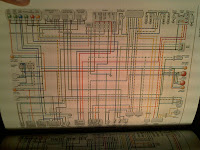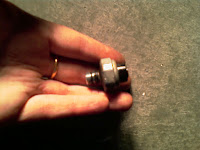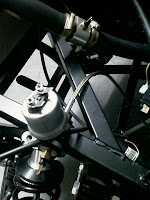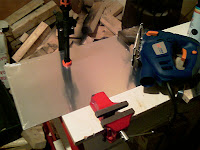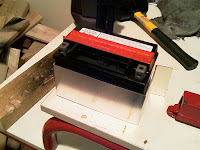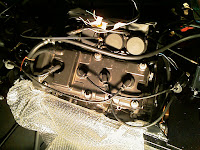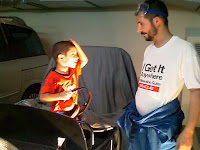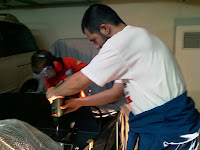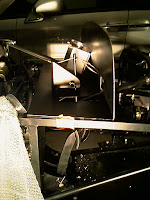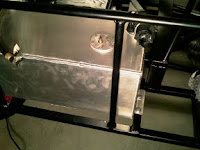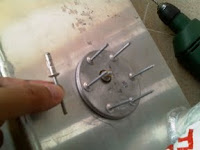Last week I mailed all my wiring doubts to
Steve from Aries and he replied with detailed instructions for where wires should go. During the week I also bought the missing terminals for the wiring work. With that email printed out and the terminals, I was confident that I could finish the engine wiring.
Before working on the wiring, I drilled four holes on the chassis to bolt my fabricated battery holder. This time I placed masking tape on the chassis, marked drilling stops with a pencil on the masking tape and then drilled over it. They were spot on and I guess this is what I need to do for all my future holes, to avoid my usual issues with "drilling with an offset". The hardest part was using my big rivet pliers under the car to rivet the part in place. But I (barely) managed it.
Going through the email Steve sent with the replies to all my doubts, I started crimping terminals on the wires lacking any. I also cut off the terminals I crimped last week to connect the fuel pump and replaced them with new terminals, since I didn't have the female type for the males that came on the loom and those I crimped were not right. Later on I cut the white that feeds the pump and used another terminal to add a new piece of wire, effectively splitting that white into two. The second wire connected to the Ignition Control Module power-in wire. I also had to replace the terminal on the loom to connect to the fuel gauge sensor, since the one that came wouldn't plug on the ETB's sender.
All that remained was to wire up earths. Using pieces of wire, connected earths from the senders and from the Ignition Control Module and Rectifier. Then linked it all to one wire with a terminal that was riveted on the chassis, together with the loom's earth. The oil temp/pressure ally casing had a small connection to wire an earth. The ally casing for the water temp didn't have such connection so I improvised a bit. Looks kind of a quick hack, might revise this later.
It's a bit hard to take relevant pictures of this work without going into excruciating detail. These two give a general look of the work. The first was taken from the front of the car, before earths were connected. The second was taken by the end of the day, from the side, showing up the earths riveted on the chassis and the fabricated part that will hold the battery. It's a pity that with this work done I feel that the engine bay is looking a bit of a mess, with all those coloured wires going everywhere... Maybe the fact that I haven't yet ripped off the tags on each wire doesn't help.
All that is missing, in the engine bay, is putting in the battery, connecting all lights and the two wires for the brake oil pressure. On the rear it's all about lights. This leaves the dash wires to crimp and connect to instruments. The lights will be done (a lot) later. The instruments, I'll have to see the minimum to run the engine.
Preparing to put the car on the floor, wanted to fit the steering wheel boss and wheel. Unfortunately, I don't have a socket big enough for the steering column bolt. Will have to go shopping for that. At least the tin-top socket driver has the correct size for the wheel bolts and has a connection point to add other sockets.
Running the engine is not far and then driving the car inside the garage space...


















